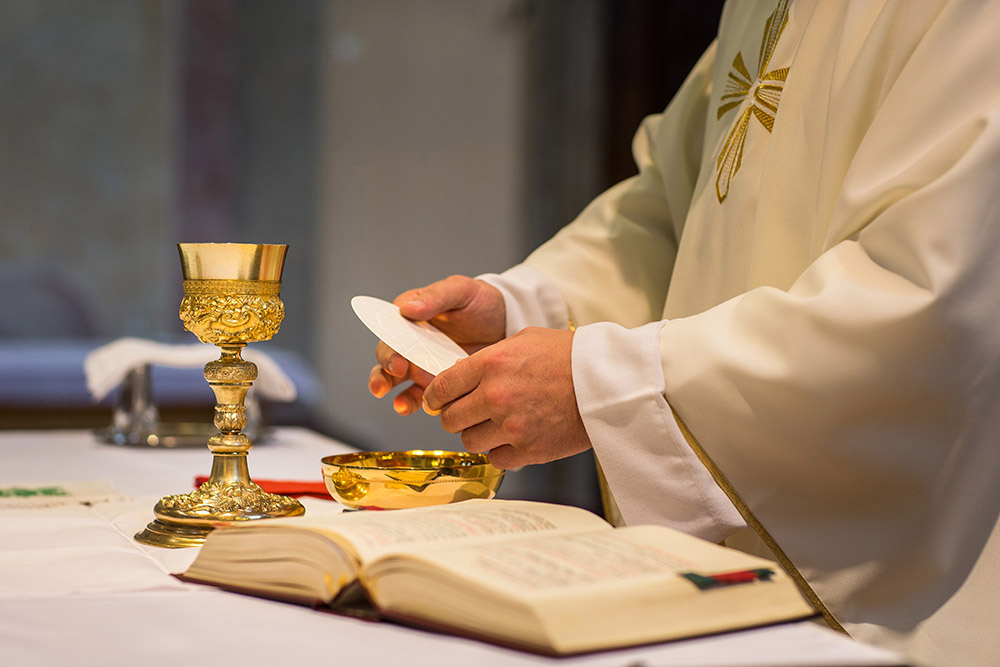From the Church’s earliest days, the way we worship God has been one of the most vital aspects of our common life. Given its centrality, then, even the way we celebrate liturgy is a topic of heated debate in the Church. And so the Church has grappled with such questions often throughout the centuries. It is, in fact, at the heart of the true meaning of the term orthodoxy. Ortho-doxa means “right praise” of God. How we praise God reflects what we believe about him.
The discipline known as “liturgical theology” deals with the importance of worship in the life of the Church. It can deal with seemingly mundane items such as the history of various liturgical items, such as a corporal (the cloth on which the paten and chalice are placed during the celebration of the Eucharist). But it also treats what is most essential in our worship, such as the meaning and importance of signs and symbols in liturgy, and the significance of liturgical participation of the laity and the related role of the clergy. Perhaps the most important question in liturgical theology is a rather simple one: What exactly constitutes liturgy?
Liturgy is a ritualistic act which, in some way, makes Christ present to his Church through signs and symbols, and which brings about the reality they symbolize. Thus the Church’s liturgy is often connected with the sacraments. But is not reducible to the sacraments alone. There are a variety of other types of liturgy: a separate, stand-alone Liturgy of the Word or the Liturgy of the Hours, for example. In all the Church’s liturgical forms, Christ is acting. His action comes through the whole Church, which is his body, gathered in his name.
As to how and why Christ is active in liturgy raises deeper theological questions treated within the discipline. For example, it has been argued by some that because bread isn’t important in some cultures, other elements might be presented as the Eucharistic species. Liturgical theology, in investigating such questions, will take into account the revelation of Christ and the tradition of the Church, and then apply it to the idea being considered. In the previous example, the discipline would say that bread is required because it is what Christ intended to be used in the Eucharist, since it is what he used when he instituted it, and what he asked be done in memory of him.
This helps us arrive at a very important aspect of the discipline. We often think of signs and symbols as given meaning only by us, as if we are the sole creators of the meaning of things. This thinking takes us to believe, then, that all signs and symbols are malleable and can change according to culture and what we think they mean. The problem with this idea is that it places the concepts of sign and symbol in a purely subjective approach without any real connection to history or tradition.
The task of liturgical theology, then, is to determine what is essential from the tradition and what is not, what is malleable and what isn’t. Even some things that are malleable — such as gestures in liturgy (as exemplified by different traditions according to different rites) — are not so easily changed because they express a deep meaning in the history of a particular ritual tradition and thereby need to be approached with care and reverence.
Words and gestures also are investigated by this discipline. They have a vital role to play not only in the liturgical life of the Church, but more specifically in her sacramental practice. Words matter, and following Jesus’ words are vital to ensuring that sacraments are validly and properly celebrated by the Church’s ministers.
If our starting point is truly that Christ is the main figure of the Church’s liturgy — the one who acts above all else — then we can begin to appreciate the need for unity in the use of words at the liturgy, especially the words Christ himself gave us. The words we use in liturgy matter because, in the end, it is Christ speaking them through the ministers of his Church. It is Christ who speaks the words of institution at each Mass, who baptizes, who confirms, who ordains, who absolves, who anoints, etc. This unity of the liturgical action becomes the unifying force for all Christian living. Our unified lived expression of faith feeds and grows from our unified liturgical life. As the ancient saying goes: lex orandi, lex credendi (the law of prayer is the law of belief). Thus liturgical theology really is an important linchpin for the Church’s unity.
In the end, our liturgical unity is expressive of the unity and universality of the Church, whereby it is Christ himself who speaks and acts through the ministers of the Church and all the members of his body gathered in his name. Our reverence toward the words, and our obedience to the Church’s instruction regarding liturgy, are rooted in respect and honor of Jesus Christ our Lord, the one who performs saving acts through ritual form.
Father Harrison Ayre is a priest of the Diocese of Victoria, British Columbia. Follow him on Twitter at @FrHarrison. Read the full series here.

